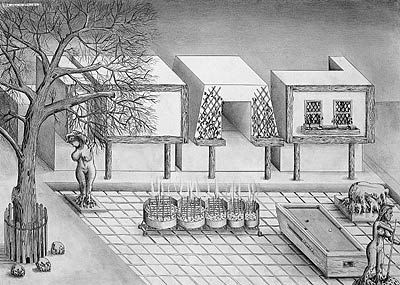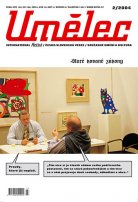| Umělec 2004/2 >> Other Times – Contemporary British Art | Просмотр всех номеров | ||||||||||||
|
|||||||||||||
Other Times – Contemporary British ArtUmělec 2004/201.02.2004 Lizzy Le Quesne | en cs |
|||||||||||||
|
City Gallery Prague
23.4–22.8. 2004 “Other Times was never intended to be simply a catalogue of contemporary British art….What would such an exhibition be?” asked curator Olga Mala. “Names come and go in the art world, some stay, some don’t. I have been to countless biennials and group shows of the current wave of young artists, and you never know where lies the real lasting quality. We were working around a theme and looking for quality artists who fitted into that. “ Nevertheless there is something in the show’s publicity (a poster image by Sam Taylor Wood slipping out of its frame… suggesting turnover, movement, fashion and the march of time), presentation (each artist in the gallery accompanied by an explanatory paragraph of text, to introduce them and to some extent explain the work) and subtitle (Contemporary British Art) which imply that the exhibition is in some measure a representation of predominant current trends in British contemporary art. And how this notion can be married to a single theme such as time seems either to force two different functions uncomfortably into one or to label the British art scene itself as concerned with time – at this time. Olga Mala vehemently denies this, saying that the show was only ever meant to be an exploration of a chosen theme, which is in turn not something they consider particularly British. “We started with the work of Tacita Dean, where we found a certain atmosphere and we dealt with our contacts in the major galleries to select a number of other pieces that related to the idea and the feeling.” This atmosphere was principally a certain kind of nostalgia. And yet…. Nostalgia. Melancholy. Loss. A harking back to better times, times when we were able, when we had the right, to dream dreams. Are these not inherently contemporary British sensations? Britain at this time is an angry country, a disappointed and divided country, a country strangled by pop culture and an all powerful, amoral, gutter press. Brits are escaping in droves to places where life is cheaper, calmer, more spiritual even. In Other Times, have Olga Mala and Karel Srp perhaps inadvertently created a portrait of a streak of the current British psyche? The modern British aesthetic has always classically contained a certain dourness, a certain lust for bitter reality, a sickly passion for the cruel light of day and a melancholy poeticism – this feeling most famously epitomized perhaps in the paintings of Lucien Freud. In the music of Blur, Pulp, The Smiths – in the poetry of Dylan Thomas, Philip Larkin, John Betcheman – in the comedy shows Monty Python, Fawlty Towers, The Office – in the paintings and photographs of many many modern and contemporary artists, British culture looks at itself with a dreary sigh and a grisly chuckle. Other Times contains a piece of that wit in the work of Geraint Evans, Michael Raedecker, Paul Noble and of straight forward, lurid, oh so British gloominess in that of George Shaw. In Shaw’s detailed, hyper realist oil paintings of nondescript slices of suburbia – a footpath through a housing estate, the corner of a brick wall, a deserted rainy football field – the rich dark reds and wet greens loom and glow like Millais’ and Rosetti’s Pre-Raphaelite paintings of nature. Shaw’s paintings refer to this former splendour (itself already bemoaning the loss of a former idyll) while depicting the grim reality of life for most people in Britain. His paintings are steeped in the scent of damp suburban grass, spilled beer and the teenage dreams unwittingly hatched and doomed while being scratched into brick. Titled Scenes from the Passion (1999) this series of wretched, unspecial places are ennobled and entombed in pure nostalgia. Cornelia Parker is a queen of cold reality, in a different but perhaps another supremely British way. Her work is practical phenomenology, semi scientific, it is about seeing and sensing a moment or a quality. With patient insistence she examines the traces of things, of actions, the leftovers from something memorable, and sees them afresh as matter and form in their own right. Her two pieces in Other Times are clean, clear, cool and yet there is a dry lust in them, a thirst for air and space within their icy elegance. Einstein’s Abstracts (1999) are photomicrographs of the chalk marks Einstein made on a blackboard in his lecture on the theory of relativity at Oxford University in 1931. Blown up to pure abstraction they resemble the trail of a rocket in outer space, a galaxy, a dusting of cocaine. In The Negative of Words (1996) the shining, curling shards of silver left over from engraving form a sorry but blue-blooded pile. Here again she displays the pure matter gouged out, left behind, vital, in the service of ideas. And the work of Tacita Dean, as lynchpin of the exhibition mood and theme, and herself an expatriated and thus perhaps disenchanted Briton (living in Berlin), indeed displays an unsurpassed melancholy and abandoned romance. And there is a burning empathy in her work. Her slightly absurd subjects are not figures of fun, but all too familiar, and tragic, monuments to human inadequacy. Two photographs of the Bubble House (1999) show this absurdist beach-side villa in the Cayman Islands. In the street view of the house, a black dog and a white dog both stand in the deserted road, looking toward the house. The moment frozen. Animal desires, light and dark, are fixed in a humid, grey day. In the internal view the house yawns like an open mouth onto the rough sea. To secure their meaning and in order to have full impact however, Dean’s photos of the Bubble House – in themselves blue, dreary and silent – do essentially also require their explanatory text. As in fact do all of her pieces, more than some others in the show. Knowing the pitiful history of this place – a luxury, futuristic beach house abandoned unfinished when its owner was imprisoned for embezzlement – is essential to understanding and receiving the work. Tinged with crime and unrealistic, unfounded desires this piece becomes a sad, humiliating story of human need and greed, as does much of Dean’s work. The images are full of atmosphere but without being presented as a painful cenotaph to impossible and ill-gotten dreams they would have only a fragment of their impact. And so Dean’s work is presented correctly, in context. Whether other works in the show really require this however is doubtful, and the texts can become irritatingly descriptive or prescriptive. It does seem that Dean’s case is different from others. With every piece she has real information to impart, which contributes, together with the images exhibited, to a particular sense of life. The texts in her case do not justify or explain her work, but add essentially to it. The house becomes more than a strangely empty and kooky modern creation in disconsolate blues and greys, but additionally poignant, hollow and preposterous. There is something uncomfortably British also about Jeremy Deller. Wide-eyed and ingenuous he has voraciously collected images of sunsets, beauty pageants and California deserts in his slide projection After the Gold Rush (2001-2002) with the typically hungry, awed and yet aloof gaze of a Britain in America. Raw US exotica: Elvis, pinball, fabulous sunsets and chilly, vacant desert dawns are pitched against the derelict buildings left behind by gold seekers, and homespun Christianity crudely stamped upon the landscape in buildings, home made signposts and bumper stickers. The piece is never free of the tourist’s eye – the curious, envious outsider – but it is a tourist looking partly for dejection and futility. The fact that Deller bought a piece of land in this area, that it was called ‘Melancholy Ranch’ and that it is near two places of mythical/criminal status (the site of much development on the atomic bomb and Charles Manson’s activities) is mentioned in the text accompanying his work. This act of buying is almost a part of his work, a part of his statement. He wanted not only to feel but to own a piece of this strange neglected place. Land ownership is a deeply British impulse. Wolfgang Tillman’s snapshot-like pictures of Concorde refer to a recent great British enterprise already dead. With the strength and romance of the sonic boom and the promise of hitherto unknown speed this masterpiece appeared and inspired before being eventually withdrawn last year for its expense and unpracticality. These uneventful pictures of the plane as a speck in the sky, in the context of dull suburbia, belie the myth of Concorde. Paintings by Dee Ferris are dreamy and girlish, in the sickly mauve, turquoise, pink and white palette of children’s toys like My Little Pony. Ideal Homes II (2002) vaguely outlines a misty white palace and pool, framed by purple foliage and decorated with specks of glitter in pastel shades. Ultimately feminine, it is like a girl’s childhood dream, fuelled by Barbie and the popular media, it is the setting of a naive modern fairytale. Out of focus and beyond reach, the image is cloudy, impossible, unreal. There is comment upon personal yearning and ambition, for luxury, security and material riches in many of the works in Other Times, alongside a sense of the vanity, absurdity and transience of such achievements. And there is much reference to ideals lost, personal desires and previous classical ideals as represented in earlier eras of painting. Gillian Carnegie, Darren Almond and Clare Richardson have been consciously inspired by classical landscape painting. Perhaps this demonstrates another continuing stream in the British aesthetic. It at least adds another dimension to Mala and Srp’s theme. This is not an edgy or street smart exhibition. It has perhaps disappointed some in the Czech Republic by not delivering another sensation of cutting edge, shocking or aggressive imagery. It has not fed the stereotype of Britain as vanguard of street fashion, birthplace of punk. “We wanted to show from British art what we find interesting, exciting….dare I say it, even beautiful” said Olga Mala. Other Times demonstrates a subtle, world-weary attitude. “Reality is perceived primarily as a fiction”. Classic and Romantic desires are set against a cool, exposed physical existence and hard facts, and subtly define, if not the British art scene, then at least a streak of Britishness.
01.02.2004
Рекомендуемые статьи
|
|||||||||||||

















Комментарии
Статья не была прокомментированаДобавить новый комментарий